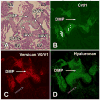Extracellular matrix and heart development
- PMID: 21618406
- PMCID: PMC3144859
- DOI: 10.1002/bdra.20810
Extracellular matrix and heart development
Abstract
The extracellular matrix (ECM) of the developing heart contains numerous molecules that form a dynamic environment that plays an active and crucial role in the regulation of cellular events. ECM molecules found in the heart include hyaluronan, fibronectin, fibrillin, proteoglycans, and collagens. Tight regulation of the spatiotemporal expression, and the proteolytic processing of ECM components by proteases including members of the ADAMTS family, is essential for normal cardiac development. Perturbation of the expression of genes involved in matrix composition and remodeling can interfere with a myriad of events involved in the formation of the four-chambered heart and result in prenatal lethality or cardiac malformations as seen in humans with congenital heart disease. In this review, we summarize what is known about the specific importance of some of the components of the ECM in relation to the cardiovascular development.
Copyright © 2011 Wiley-Liss, Inc.
Figures


References
-
- Abu-Issa R, Kirby ML. Heart field: from mesoderm to heart tube. Annu Rev Cell Dev Biol. 2007;23:45–68. - PubMed
-
- Astrof S, Kirby A, Lindblad-Toh K, Daly M, Hynes RO. Heart development in fibronectin-null mice is governed by a genetic modifier on chromosome four. Mech Dev. 2007b;124(7–8):551–558. - PubMed
Publication types
MeSH terms
Grants and funding
LinkOut - more resources
Full Text Sources

